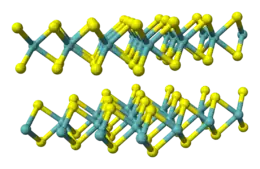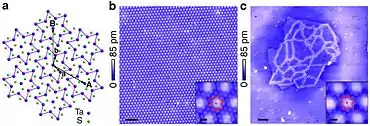Tantalum(IV) sulfide
Tantalum(IV) sulfide is the inorganic compound with the formula TaS2. It is a layered compound with three-coordinate sulfide centres and trigonal prismatic metal centres. It is structurally similar to the more famous material molybdenum disulfide, MoS2. TaS2 is a semiconductor with d1 electron configuration. Although an obscure material otherwise, TaS2 has been the subject of numerous studies because it is a versatile host for intercalation of electron donors,[2] and because it exhibits unusual phase transitions at low temperatures.
 Crystal structure showing two stacked S-Ta-S sheets | |
| Names | |
|---|---|
| Other names
tantalum disulfide | |
| Identifiers | |
3D model (JSmol) |
|
| ECHA InfoCard | 100.032.047 |
PubChem CID |
|
CompTox Dashboard (EPA) |
|
| |
| |
| Properties | |
| TaS2 | |
| Molar mass | 245.078 g/mol[1] |
| Appearance | black crystals[1] |
| Density | 6.86 g/cm3[1] |
| Melting point | >3000 °C [1] |
| Insoluble[1] | |
| Hazards | |
EU classification (DSD) (outdated) |
not listed |
| Related compounds | |
Other anions |
Tantalum telluride |
Except where otherwise noted, data are given for materials in their standard state (at 25 °C [77 °F], 100 kPa). | |
| Infobox references | |
Preparation
TaS2 is prepared by reaction of powdered tantalum and sulfur at ~900 °C.[3] It is purified and crystallized by chemical vapor transport using iodine as the transporting agent:[4]
- TaS2 + 2 I2 ⇌ TaI4 + 2 S
Properties

Three major crystalline phases are known for TaS2: trigonal 1T with one S-Ta-S sheet per unit cell, hexagonal 2H with two S-Ta-S sheets, and rhombohedral 3R with three S-Ta-S sheets per cell; 4H and 6R phases are also observed, but less frequently. These polymorphs mostly differ by the relative arrangement of the S-Ta-S sheet rather than the sheet structure.[5]
2H-TaS2 is a superconductor with the bulk transition temperature TC = 0.5 K, which increases to 2.2 K in flakes with a thickness of a few atomic layers.[3] The bulk TC value increases up to ~8 K at 10 GPa and then saturates with increasing pressure.[6] In contrast, 1T-TaS2 starts superconducting only at ~2 GPa; as a function of pressure its TC quickly rises up to 5 K at ~4 GPa and then saturates.[7]
At ambient pressure and low temperatures 1T-TaS2 is a Mott insulator.[7] Upon heating it changes to a Triclinic charge density wave (TCDW) state at TTCDW ~ 220 K,[8][9][10] to a nearly commensurate charge density wave (NCCDW) state at TNCCDW ~ 280 K,[11] to an incommensurate CDW (ICCDW) state at TICCDW ~ 350 K,[11] and to a metallic state at TM ~ 600 K.
In the CDW state the TaS2 lattice deforms to create a periodic Star of David pattern. Application of (e.g. 50fs) optical laser pulses[12] or voltage pulses (~2–3 V) through electrodes[13] or in a scanning tunneling microscope (STM) to the CDW state causes it to drop electrical resistance and creates a "mosaic state" consisting of nanometer-sized domains, where both the domains and their walls exhibit metallic conductivity. This mosaic structure is metastable and gradually disappears upon heating.[4][14][13]
References
| Wikimedia Commons has media related to Tantalum disulfide. |
- Haynes, William M., ed. (2011). CRC Handbook of Chemistry and Physics (92nd ed.). Boca Raton, FL: CRC Press. p. 4.93. ISBN 1439855110.
- Revelli, J. F.; Disalvo, F. J. (1995). "Tantalum Disulfide (TaS2) and Its Intercalation Compounds". Inorganic Syntheses. Inorganic Syntheses. 30. p. 155. doi:10.1002/9780470132616.ch32. ISBN 9780470132616.
- Navarro-Moratalla, Efrén; Island, Joshua O.; Mañas-Valero, Samuel; Pinilla-Cienfuegos, Elena; Castellanos-Gomez, Andres; Quereda, Jorge; Rubio-Bollinger, Gabino; Chirolli, Luca; Silva-Guillén, Jose Angel; Agraït, Nicolás; Steele, Gary A.; Guinea, Francisco; Van Der Zant, Herre S. J.; Coronado, Eugenio (2016). "Enhanced superconductivity in atomically thin TaS2". Nature Communications. 7: 11043. arXiv:1604.05656. Bibcode:2016NatCo...711043N. doi:10.1038/ncomms11043. PMC 5512558. PMID 26984768.
- Cho, Doohee; Cheon, Sangmo; Kim, Ki-Seok; Lee, Sung-Hoon; Cho, Yong-Heum; Cheong, Sang-Wook; Yeom, Han Woong (2016). "Nanoscale manipulation of the Mott insulating state coupled to charge order in 1T-TaS2". Nature Communications. 7: 10453. arXiv:1505.00690. Bibcode:2016NatCo...710453C. doi:10.1038/ncomms10453. PMC 4735893. PMID 26795073.
- Dunnill, Charles W.; MacLaren, Ian; Gregory, Duncan H. (2010). "Superconducting tantalum disulfide nanotapes; growth, structure and stoichiometry" (PDF). Nanoscale. 2 (1): 90–7. Bibcode:2010Nanos...2...90D. doi:10.1039/B9NR00224C. PMID 20648369.
- Freitas, D. C.; Rodière, P.; Osorio, M. R.; Navarro-Moratalla, E.; Nemes, N. M.; Tissen, V. G.; Cario, L.; Coronado, E.; García-Hernández, M.; Vieira, S.; Núñez-Regueiro, M.; Suderow, H. (2016). "Strong enhancement of superconductivity at high pressures within the charge-density-wave states of 2H−TaS2 and 2H−TaSe2". Physical Review B. 93 (18): 184512. arXiv:1603.00425. Bibcode:2016PhRvB..93r4512F. doi:10.1103/PhysRevB.93.184512. S2CID 54705510.
- Sipos, B.; Kusmartseva, A. F.; Akrap, A.; Berger, H.; Forró, L.; Tutiš, E. (2008). "From Mott state to superconductivity in 1T-TaS2". Nature Materials. 7 (12): 960–5. Bibcode:2008NatMa...7..960S. doi:10.1038/nmat2318. PMID 18997775.
- Tanda, Satoshi; Sambongi, Takashi; Tani, Toshiro; Tanaka, Shoji (1984). "X-Ray Study of Charge Density Wave Structure in 1T-TaS2". J. Phys. Soc. Jpn. 53 (2): 476. Bibcode:1984JPSJ...53..476T. doi:10.1143/JPSJ.53.476.
- Tanda, Satoshi; Sambongi, Takashi (1985). "X-ray study of the new charge-density-wave phase in 1T-TaS2". Synthetic Metals. 11 (2): 85–100. doi:10.1016/0379-6779(85)90177-8.
- Coleman, R. V.; Giambattista, B.; Hansma, P.K; Johnson, A.; McNairy, W.W.; Slough, C.G. (1988). "Scanning tunnelling microscopy of charge-density waves in transition metal chalcogenides". Advances in Physics. 37 (6): 559–644. doi:10.1080/00018738800101439.
- Wilson, J.A.; Di Salvo, F.J.; Mahajan, S. (1975). "Charge-density waves and superlattices in the metallic layered transition metal dichalcogenides". Advances in Physics. 24 (2): 117–201. doi:10.1080/00018737500101391.
- Stojchevska, L.; Vaskivskyi, I.; Mertelj, T.; Kusar, P.; Svetin, D.; Brazovskii, S.; Mihailovic, D. (2014). "Ultrafast Switching to a Stable Hidden Quantum State in an Electronic Crystal". Science. 344 (6180): 177–180. arXiv:1401.6786. doi:10.1126/science.1241591. ISSN 0036-8075.
- Vaskivskyi, I.; Gospodaric, J.; Brazovskii, S.; Svetin, D.; Sutar, P.; Goreshnik, E.; Mihailovic, I.A.; Mertelj, T.; Mihailovic, D. (2014). "Ultrafast Switching to a Stable Hidden Quantum State in an Electronic Crystal". Science. 344 (6180): 177–180. doi:10.1126/sciadv.1500168. ISSN 0036-8075.
- Ma, Liguo; Ye, Cun; Yu, Yijun; Lu, Xiu Fang; Niu, Xiaohai; Kim, Sejoong; Feng, Donglai; Tománek, David; Son, Young-Woo; Chen, Xian Hui; Zhang, Yuanbo (2016). "A metallic mosaic phase and the origin of Mott-insulating state in 1T-TaS2". Nature Communications. 7: 10956. arXiv:1507.01312. Bibcode:2016NatCo...710956M. doi:10.1038/ncomms10956. PMC 4792954. PMID 26961788.